Content curation isn’t hitting copy-paste like you’re cramming information to meet the word count for that overdue assignment at 2 AM. It’s the art of finding, filtering, and sharing the best content that already exists while adding your own smart commentary. Think of yourself as the Netflix algorithm, but for your niche and way less creepy about your viewing habits.
In a world where everyone’s shouting into the digital void, smart marketers have figured out that sometimes the best strategy is knowing when to amplify someone else’s voice instead of constantly clearing your throat.
What is curated content?
Let’s get the content curation meaning straight: it’s the process of discovering, gathering, and presenting existing content that’s relevant to your audience and industry.
That’s the formal definition, but in layman’s terms, what is content curation exactly? It’s like being a museum curator, but instead of ancient artifacts, you’re showcasing the best tweets, articles, videos, and insights that matter to your people.
In a nutshell, you’re strategically selecting content that aligns with your brand values, speaks to your audience’s pain points, and positions you as someone worth following.
Also Read: How to create a content strategy that works? 7 easy steps + Template
Benefits of content curation
Content curation makes you the friend who always knows the best restaurant recommendations, except your recommendations are content pieces that make your audience smarter, more informed, or entertained.
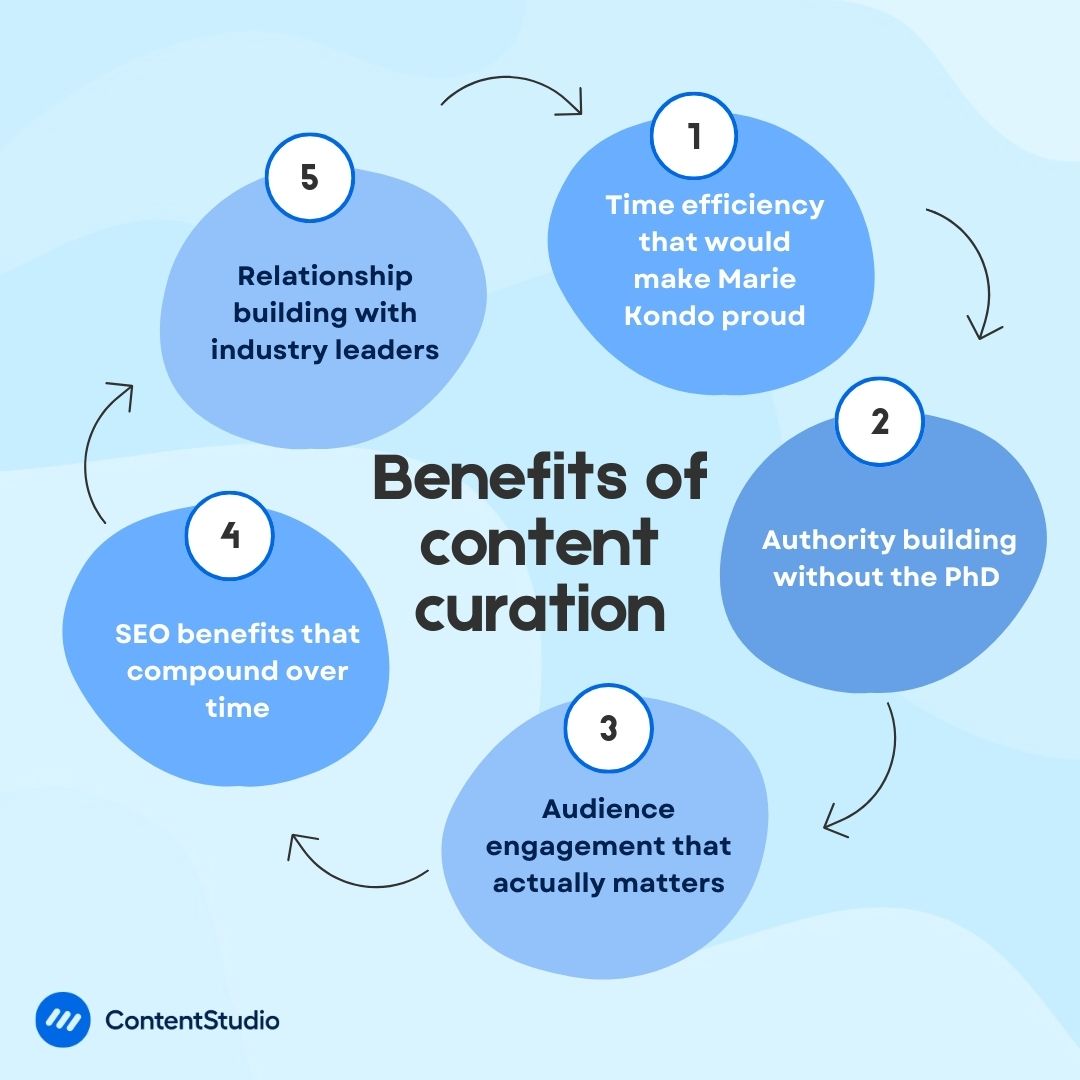
Here’s why smart brands are all over it:
Time efficiency that would make Marie Kondo proud
Creating original content 24/7 is exhausting and, frankly, unnecessary. Curation lets you maintain consistent posting without burning out your creative team or yourself.
Authority building without the PhD
When you consistently share high-quality content, you become the go-to source in your field. Your audience starts seeing you as the person who always knows what’s worth their time.
Audience engagement that actually matters
Curated content often sparks more meaningful conversations than promotional posts. People love discussing interesting articles, debating hot takes, or sharing their own experiences related to what you’ve shared.
SEO benefits that compound over time
Quality curated content can drive traffic, increase time on site, and show search engines that your site is a valuable resource hub.
Relationship building with industry leaders
When you regularly share and credit other creators’ work thoughtfully, you’re building relationships with influencers and thought leaders in your space.
Content creation vs content curation
Here’s the thing everyone gets wrong: it’s not creation versus curation. It’s creation AND curation working together like the marketing power couple version of bonnie and clyde.
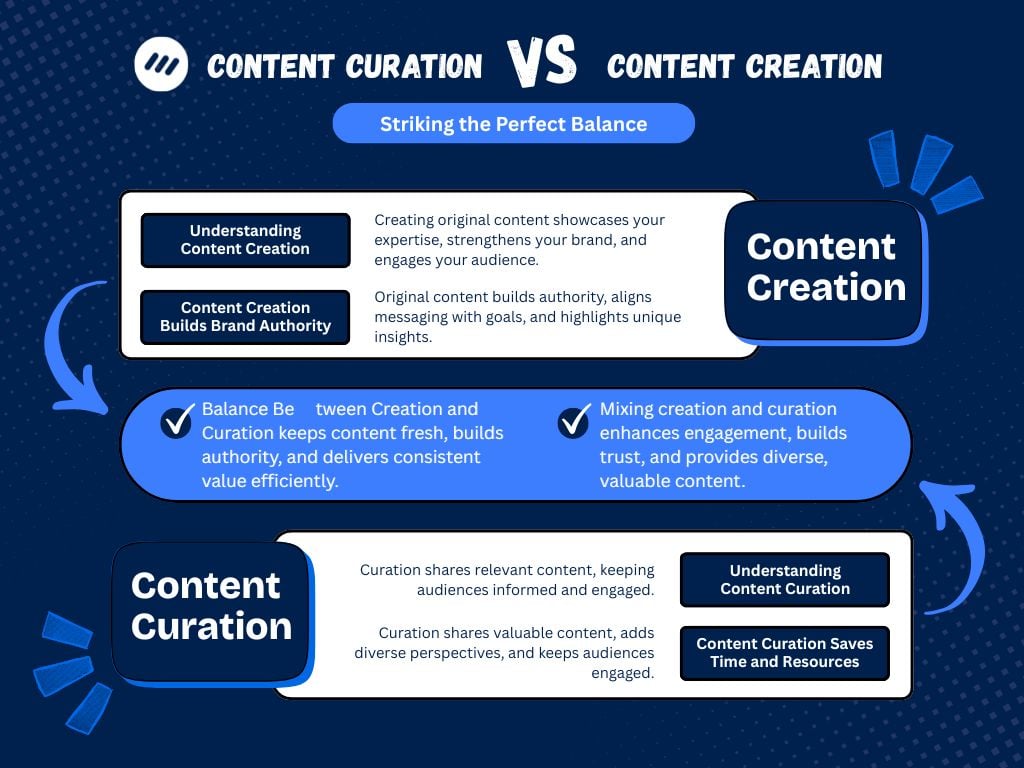
Content creation is you in full creative mode. Writing original blog posts, filming videos, designing infographics, and crafting social media posts from scratch. It’s 100% your voice, your ideas, and your perspective. It’s also time-intensive and can lead to creative burnout faster than you can say “content calendar.”
Content curation is you being the smart connector. Finding amazing content that already exists and presenting it to your audience with your own insights, commentary, or context. You’re adding value through selection, organization, and perspective.
The best move is to blend both. Maybe write one original blog post per week but curate 3-4 relevant pieces to share throughout the week. Or create original videos but curate industry news to share in your Stories.
Like hosting a dinner party! You might make the main course (original content) but serve amazing wine you carefully selected (curated content) and maybe some artisanal cheese you discovered (more curated content). The combination creates an experience that’s way better than just serving pasta and calling it a day.
Content curation strategy
A solid curation strategy adopts a systematic approach that aligns with your overall marketing goals and brand voice.
Start with your audience’s needs
What keeps them up at night? Which industry trends do they need to know about? What type of content makes them stop scrolling and actually engage? Your curated content should solve problems, answer questions, or provide entertainment value.
Define your content pillars
If you’re a marketing agency, your pillars might include industry trends, case studies, marketing tools, and thought leadership pieces. Having clear pillars helps you stay focused and avoid sharing random content that doesn’t serve your brand.
Establish your voice and perspective
Just because you’re sharing someone else’s content doesn’t mean your voice disappears. Add commentary, ask questions, share your take, or explain why this piece matters to your audience.
Create a content mix ratio
A good rule of thumb is the 80/20 rule flipped for curation: 80% valuable content (mix of curated and educational), 20% promotional. But honestly, find what works for your audience and industry.
Set quality standards
Not all content deserves your endorsement. Develop criteria for what makes something worth sharing: credible sources, relevant topics, high engagement potential, and alignment with your brand values.
How to curate content step by step
Here’s your roadmap to content curation marked up with actionable steps:
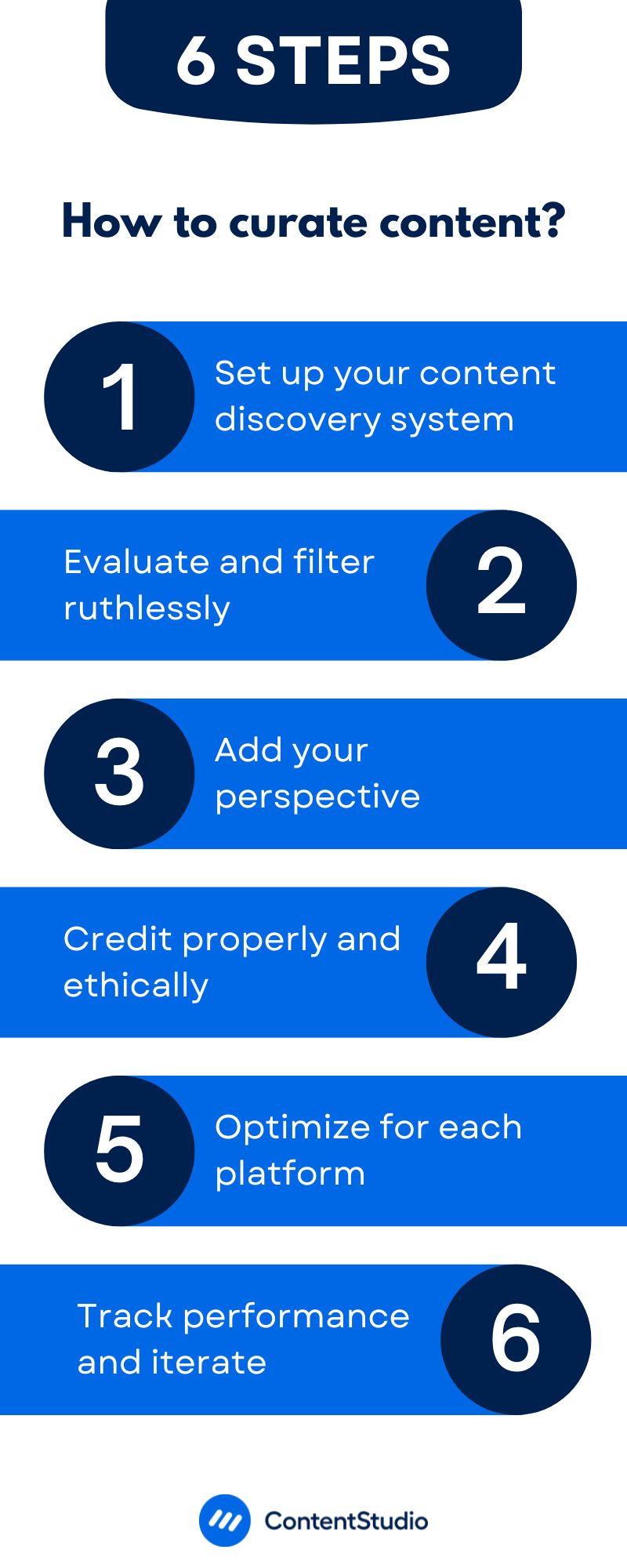
Step 1: Set up your content discovery system
Use tools like Feedly, Google Alerts, or Twitter Lists to monitor industry publications, competitor content, and trending topics. Create a system that brings relevant content to you instead of hunting for it daily.
Step 2: Evaluate and filter ruthlessly
Not everything that crosses your feed deserves your audience’s attention. Ask yourself: Is this accurate? Is it relevant to my audience? Does it add value? Would I personally find this interesting?
Step 3: Add your perspective
This is where you transform from content aggregator to content curator. Write meaningful commentary, ask thought-provoking questions, share personal experiences related to the content, or explain why it matters.
Step 4: Credit properly and ethically
Always tag the original creator, include proper attribution, and link back to the source. This isn’t just good karma; it’s building relationships and respecting intellectual property.
Step 5: Optimize for each platform
The same piece of content might need different treatment for LinkedIn versus Instagram versus Twitter. Repurpose and refine your commentary and presentation to fit platform norms and your audience’s behavior.
Step 6: Track performance and iterate
Monitor which curated content performs best. What topics resonate? What commentary style gets engagement? Use these insights to refine your curation strategy.
Social media content curation
Social media is where content curation really flexes its muscles. Each platform has its own curation culture, and understanding these nuances is crucial for success.
LinkedIn loves thought leadership and industry insights: Share articles with professional commentary, ask questions that spark meaningful discussions, and position curated content within the context of business trends or career development.
Twitter relies on real-time curation: Breaking news, hot takes, quick insights, and threaded commentary work well. Twitter’s retweet culture makes it naturally curation-friendly, but adding your own comments makes your shares more valuable.
Instagram requires visual curation: You might curate quotes, behind-the-scenes content from industry events, or user-generated content. Stories are perfect for quick curation with polls, questions, or commentary stickers.
TikTok curation often involves trends and reactions: Curating trending sounds, participating in challenges, or creating reaction content to viral videos. The platform’s format makes original creation feel more natural, but smart curation still has its place.
Plan, schedule, share, and analyze content for 15+ social media channels.
Try ContentStudio for FREE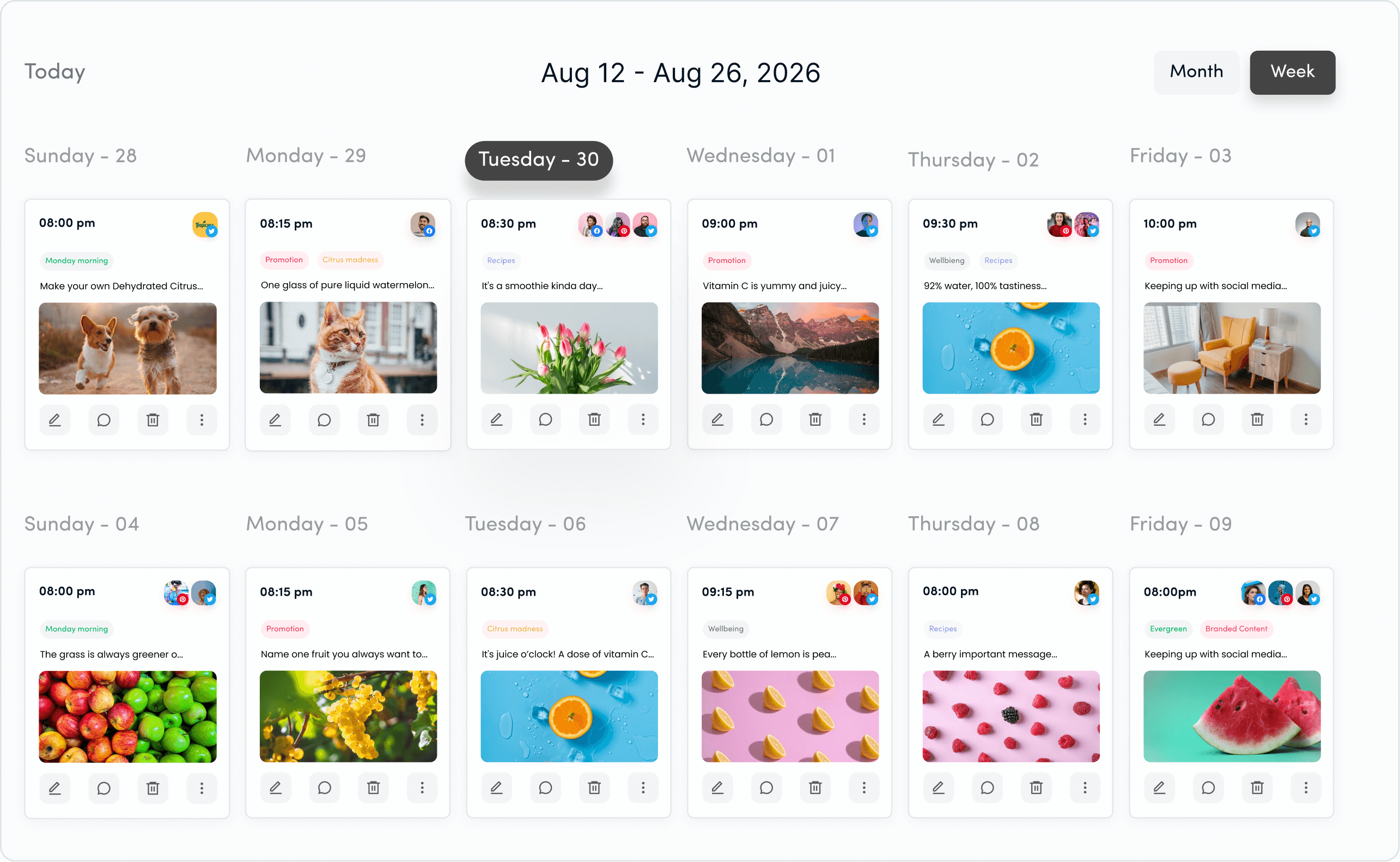
How to use content curation on social media?
Social media content curation isn’t just about hitting the share button. It’s about becoming a trusted filter for your audience’s infinite scroll.
Create themed content days
Maybe Mondays are for motivational industry quotes, Wednesdays for case study breakdowns, and Fridays for fun industry memes. Consistency helps your audience know what to expect.
Use the sandwich method
Layer curated content between your original posts. This keeps your feed interesting while reducing the pressure to constantly create new content.
Engage with the original post first
Before sharing something, engage with it on the original platform. Like, comment, or share it there too. This shows respect for the creator and can help build relationships.
Create collections or highlights
Use Instagram Highlights, Twitter Moments, or LinkedIn newsletters to organize curated content into themed collections. This adds extra value and makes your curation more discoverable.
Time your shares strategically
Don’t just dump curated content during slow periods. Research the best times to post, and share valuable content when your audience is most active and likely to engage.
Also Read: How to craft a winning social media content strategy?
Content curation examples
Let’s look at some brands and creators who’ve mastered the curation game:
1. Morning Brew
Morning Brew has built an empire around curating business news with wit and personality. They take complex financial topics and make them digestible for their young professional audience, adding commentary that’s both educational and entertaining.
2. Gary Vaynerchuk
Gary Vaynerchuk regularly curates content on LinkedIn but always adds substantial commentary that provides additional value. He doesn’t just share; he expands on ideas, offers counterpoints, or relates content to his own experiences.
3. Content Marketing Institute
Content Marketing Institute curates content across multiple channels but organizes it strategically around their content pillars: strategy, creation, distribution, and measurement. Their curation feels purposeful rather than random.
5 social media content curation tools you need
The right tools can turn content curation from a time-sucking task into a streamlined system:
Feedly
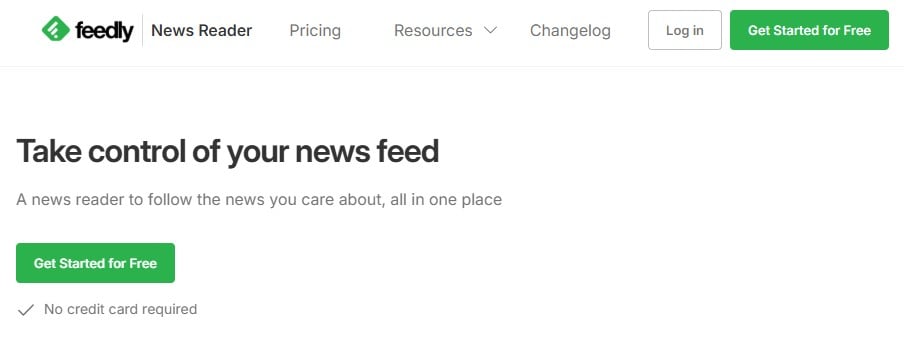
Feedly organizes all your content sources into one clean interface. Create custom feeds for different topics, save articles for later, and integrate with other tools for a seamless workflow.
Scoop.it

Scoop.it is like your creative space on the internet, perfect for showcasing your expertise. With this tool, you can easily gather and share awesome content, creating your online magazines.
BuzzSumo
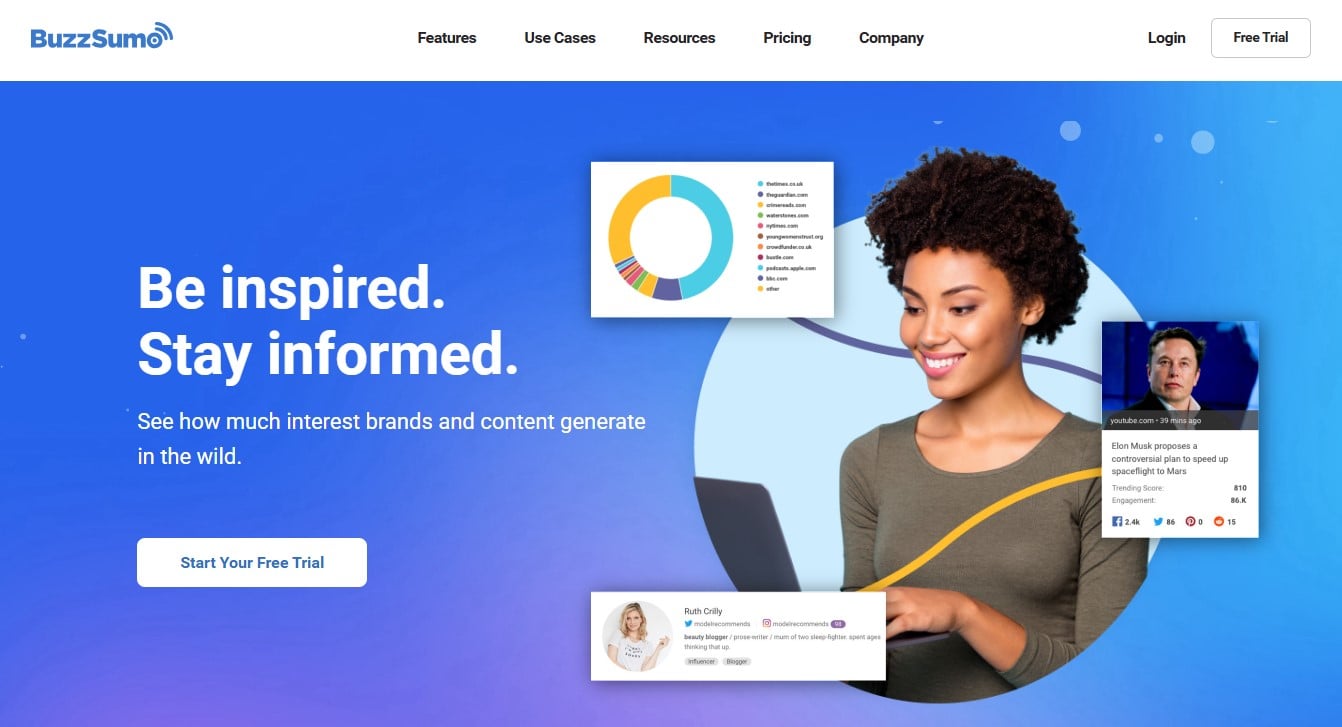
BuzzSumo helps you find the most shared content in your industry. See what’s trending and who’s sharing it, and identify potential content for your own curation strategy.
Google Alerts
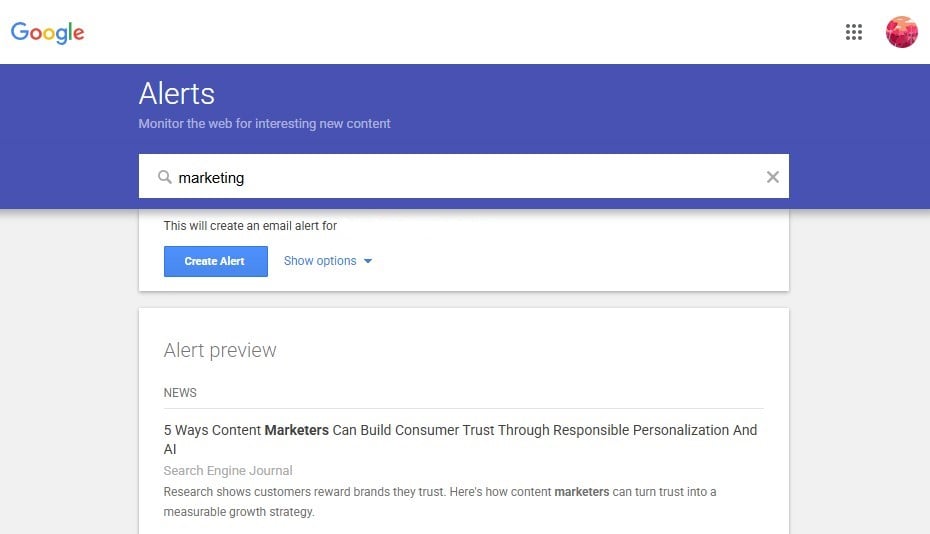
Google Alerts sends you email notifications when specific keywords or phrases appear online. Set up alerts for your industry terms, competitor names, or trending topics.
Curata
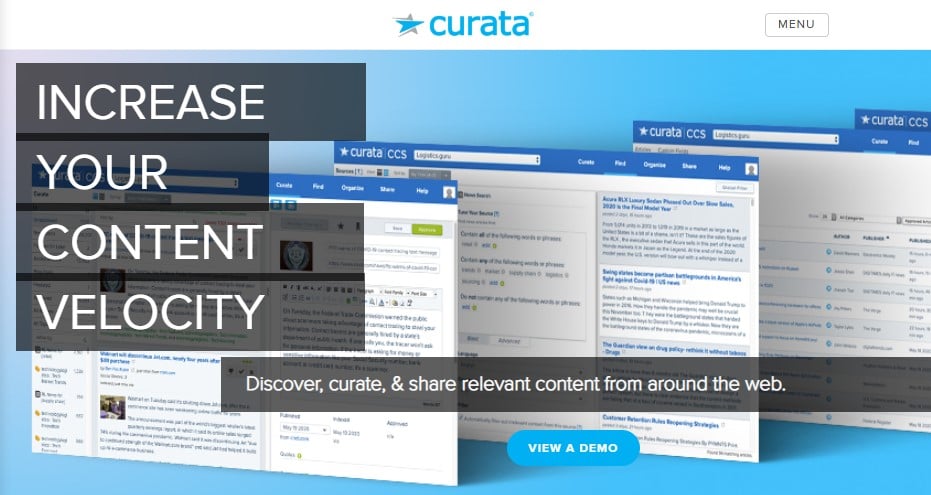
Curata is the best helper for a business that wants to lead in the creative content market. With the help of this tool, you can easily find, organize, and share the best content. It offers automated discovery.
8 best practices for social media content curation
Want to curate like a pro? Follow these content curation best practices:
1. Always add value beyond the original post
When you share content, contribute to it by building upon it information and perspectives that are valuable and matter to your audience. Add context, ask questions, or share your experience.
2. Credit creators properly and consistently
Tag the original author, mention the publication, and link back to the source. This builds relationships and shows you respect intellectual property.
3. Maintain a consistent voice across curated content
Your personality should shine through even when sharing others’ work. Your commentary and perspective are what make curated content valuable to your specific audience.
4. Quality over quantity, always
Better to share three amazing pieces per week than seven mediocre ones. Your audience’s attention is precious; treat it that way.
5. Mix content types and formats
Don’t just curate articles. Share videos, infographics, podcasts, tweets, LinkedIn posts, and other formats to keep your feed visually interesting and engaging.
6. Time your content curation strategically
Share content when your audience is most active, but also consider the content’s lifespan. Breaking news needs immediate sharing; evergreen content can be saved for optimal timing.
7. Create themed curation campaigns
Group related curated content around events, trends, or topics. This creates more impact than random sharing and positions you as a thought leader in specific areas.
8. Track performance and iterate constantly
Monitor which curated content gets the most engagement, drives traffic, or generates leads. Use these insights to refine your curation strategy and focus on what works.
Conclusion
The brands winning at digital content curation understand that their value isn’t just in what they create, but in what they choose to amplify and how they frame it for their audience. While your audience appreciates originality, they also appreciate you being the filter, the context provider, and the trusted voice that helps them navigate information overload. Master curation, and you’ll build authority while actually working smarter, not harder.
FAQs
What does it mean to curate content
Content curation means finding, filtering, and sharing existing valuable content with your audience while adding your own commentary or perspective. It’s about being a trusted filter in an information-overloaded world, selecting the best content that serves your audience’s needs and interests.
What is the role of a content curator?
A content curator acts as a trusted filter and context provider for their audience. They discover high-quality content from various sources, evaluate it for relevance and accuracy, and present it with additional value through commentary, insights, or personal perspective. Content curators help their audience cut through information overload to find what’s truly worth their time.
What is curated content on social media
Curated content on social media refers to valuable posts, articles, videos, or other content that you find and share from other creators, brands, or publications. The key is adding your own commentary, insights, or perspective to provide additional value to your followers while properly crediting the original source.

Leave a Reply